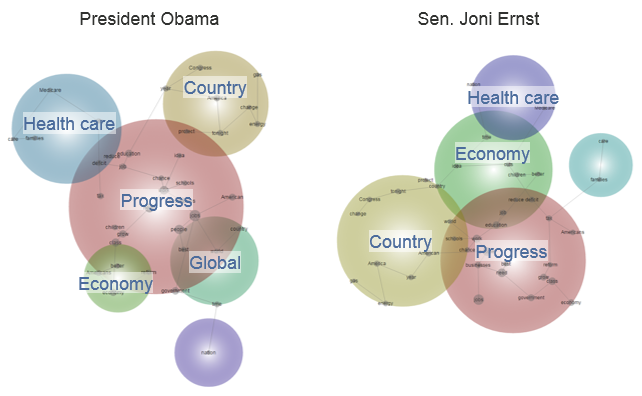Measuring the 2015 State of the Union

Using the new science of communication analytics to analyze President Obama’s statement and Joni Ernst’s Response
Using our communication analytics technology, built on state-of-the-art communications research, data science technology, and audience testing, we objectively analyzed both President Obama’s State of the Union remarks and the Republican Party’s response (from Senator Joni Ernst) to uncover any hidden findings only data-driven linguistic analysis could highlight.
Key questions:
- Did Obama and Ernst focus on the same issues?
- Was one speech delivered more confidently than the other? Is one party communicating more optimism about our future?
- What percentage of content was focused on attacking the other party? Additionally, we wondered whether the Republican response was crafted to appeal to women voters. According to a recent article from NPR, the Republican Party is making more of an effort to reach out to women. This strategy is in response to studies that have shown that women voters traditionally are more likely to agree with the Democratic stance on issues.
- Did the Republican response reach women voters?
To answer these questions, we analyzed the transcripts from both parties with our natural language processing and linguistic mapping tools. We then benchmarked the results against our communications database, containing over 100,000 pieces of political and organizational communications content.
Analytics Findings:
- Did Obama and Ernst focus on the same issues? We used linguistic mapping technology, implementing a topical hierarchy algorithm to quantify the issues of focus for each presenter

Interestingly, the President included 2.5x more references to the global landscape than the Republican response, a surprising departure from typical Republican practice. Further, there were only two mentions of health care (as well as one reference to ObamaCare as a failed practice), a 91% decrease from prior Republican responses to President Obama’s State of the Union speeches.
The Republicans seem to be signaling a substantial shift from their typical messaging points. Time will tell if this is representative of their strategy in the final two years of President Obama’s term.
- Was one speech delivered more confidently than the other? Is one party communicating more optimism about our future?Ms. Ernst was more optimistic, but Mr. Obama was more confident. (Tweet this)
The language used by Ms. Ernst displayed 30.6% more optimism than the language displayed by Mr. Obama. However, Mr. Obama’s speech displayed 36.8% more confident language than Ms. Ernst’s response.
Both politicians’ optimism and confidence were lower than the historical average displayed by their parties. - What percentage of content was focused on attacking the other party? Ms. Ernst used 8x the number of references to the other party as Mr. Obama. (Tweet this)
0.8% of Ms. Ernst’s speech referenced decisions, actions, or stances held by the Democratic Party. 0.1% of Mr. Obama’s speech referenced the Republican Party.
- Did the Republican response reach women voters?
In an attempt to appeal to women, research suggests the Republicans would be best served by focusing more on storytelling and less on facts and figures. Further, it has been noted that using a more compassionate tone is an effective way to message to women.
Joni Ernst increased the typical number of stories in a Republican State of the Union response by 2x. (Tweet this)
Our language analytics found that Ms. Ernst used 4 examples of qualitative supporting material (stories, quotes, anecdotes) for every example of quantitative material (statistics, facts and figures). The average GOP response since Mr. Obama first took office only provided 2 qualitative examples for every quantitative example.

Although Ms. Ernst did utilize more stories in her response, she did not use a more compassionate tone. We found the overall sentiment of her language to be a negative leaning 39.0% (50% is considered neutral language). The average sentiment of the GOP’s historical responses is 51.5%. The sentiment displayed in the language used by Mr. Obama last night was a more neutral 41.7%.
While the use of storytelling in the Republican response indicates a strategy to focus more on women voters, the fewer instances of language demonstrating compassion indicates the Republican response may not have fully resonated with women.
There’s much to be learned from the content analytics, but research also tells us that it’s not just what you say, it’s also how you say it. Mr. Obama has worked hard to develop a unique style during his time in the presidency. Ms. Ernst is newer to the national political platform, and her communications delivery lacked the emotional inflection and impact we would hope to see from a political communicator.


